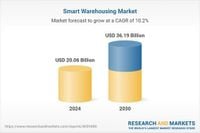The global smart warehousing market is experiencing rapid growth, driven by the rise of e-commerce and the integration of advanced technologies. Valued at USD 20.06 billion in 2024, this market is projected to reach USD 36.19 billion by 2030, with a compound annual growth rate (CAGR) of 10.17%. This transformation is characterized by the adoption of automation, robotics, IoT, AI, and cloud platforms, which are redefining warehouse operations and enhancing efficiency.
According to a report by GLOBE NEWSWIRE published on April 18, 2025, the smart warehousing market is evolving to meet the demands of modern logistics and supply chain management. The surge in e-commerce has created an urgent need for optimized warehousing solutions, as companies strive to enhance customer satisfaction and reduce delivery times.
Key players in this market include industry giants such as Honeywell, Siemens, and ABB, who are at the forefront of developing innovative warehousing technologies. These advancements not only streamline operations but also respond to the growing consumer expectation for rapid order fulfillment.
One of the primary drivers of this market growth is the increasing demand for supply chain optimization. As companies expand their e-commerce capabilities, they require sophisticated warehousing solutions that can handle complex logistics. The integration of IoT devices allows for real-time tracking of inventory and shipments, while AI algorithms optimize inventory management and order processing.
Moreover, cloud deployments are gaining traction due to their scalability and cost-effectiveness. Businesses of all sizes are recognizing the benefits of cloud-based systems, which provide accessibility and flexibility in managing warehouse operations.
However, the smart warehousing market does face significant challenges. High implementation costs can deter small and medium-sized enterprises (SMEs) from investing in these technologies. The initial investment in advanced systems and the skilled labor required for maintenance can be substantial. Additionally, concerns regarding data security and complex integration processes further complicate the adoption of smart warehousing solutions.
Despite these hurdles, the potential for enhanced efficiency and improved customer experiences continues to attract interest across various sectors. The report highlights that the expansion of cross-border e-commerce, expected to exceed USD 1 trillion by 2025, is fueling demand for strategic warehousing locations worldwide.
In parallel, the economic impacts of artificial intelligence (AI) are becoming increasingly evident. As detailed in Stanford’s 2024 AI Index, global investment in AI surged to USD 252.3 billion in 2024, marking a 25.5% increase from the previous year. This growth is largely driven by private investment, which accounted for a significant portion of the funding, reaching USD 109.1 billion in the United States alone.
Investment in generative AI, a subset of overall AI investment, stood at USD 33.9 billion, representing over 13% of total AI funding. This figure is particularly notable given that investment in generative AI was less than USD 5 billion just three years prior. Private equity investment in AI has also seen a substantial increase, with the average investment per deal rising from USD 31.6 million in 2023 to USD 45.4 million in 2024.
The United States continues to lead the world in AI investment, outpacing China and the United Kingdom by significant margins. Since 2013, US private investors have contributed over USD 400 billion to the AI sector, a testament to the country's dominance in this rapidly evolving field.
Moreover, the focus of AI investment is shifting towards specialized applications, particularly in sectors like healthcare and fintech. Investment in healthcare AI reached USD 14 billion, while fintech AI garnered USD 7 billion, both tripling their respective funding levels from the previous year.
In terms of enterprise usage, 2024 marked a pivotal year as businesses began to embrace AI more broadly. A survey by McKinsey found that 78% of organizations reported utilizing AI in at least one business function, a significant increase from 55% in 2023. The deployment of generative AI in business contexts rose dramatically from 33% in 2023 to 71% in 2024.
However, while enterprises reported modest revenue gains from AI implementation, the overall impact on workforce dynamics remains complex. Surprisingly, fewer employers predict workforce reductions due to AI compared to previous years. Instead, many executives expect AI to have minimal impact on employment levels, with nearly 40% anticipating that AI deployment will result in hiring additional employees.
The Index highlights that productivity improvements from AI usage, while material, are modest. Enterprises reported varied gains, with 46.8% experiencing increases of 0-20%. Notably, AI appears to equalize employee performance, enhancing productivity among less experienced workers.
AI's transformative potential is further underscored by its ability to reduce mental demand in the workplace and improve the accuracy of tasks performed by non-native English speakers. A Microsoft study indicated that AI automation could enable a 45% reduction in perceived mental demand and improve the quality of professional reports.
Despite these advancements, the demand for AI-related skills in the labor market remains relatively low. In 2024, AI-related jobs accounted for only 1.8% of all job postings in the United States, indicating that while AI is reshaping industries, the workforce is still adapting to these changes.
As companies continue to navigate the evolving landscape of smart warehousing and AI integration, the focus will likely remain on enhancing operational efficiency and customer satisfaction. The future of these sectors will depend on overcoming existing challenges and leveraging technological advancements to meet the demands of a rapidly changing market.



